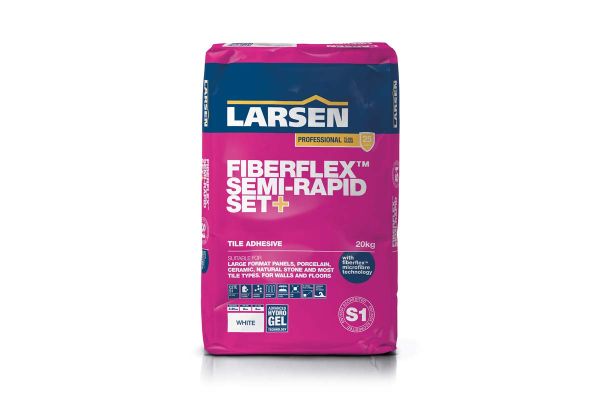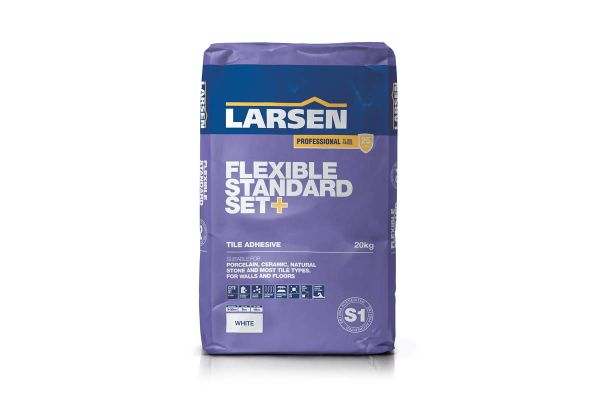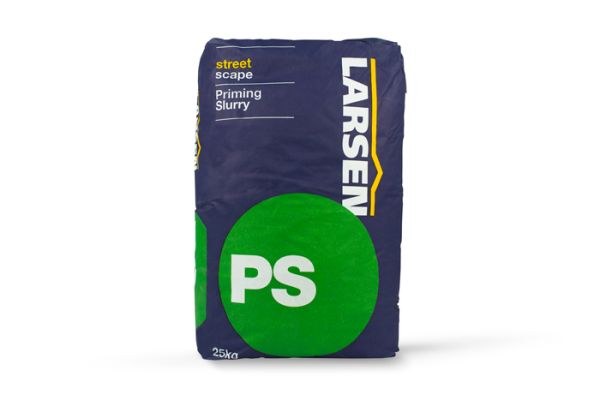Larsen products for superior results
Explore our range of Larsen Streetscape PS Primer and adhesives, essential ancillary products for any paving installation. Designed and manufactured by Larsen, a leader in the construction products industry who are known for their innovative and reliable hard-landscaping accessories, these products are crafted to ensure superior adhesion between paving slabs and the sub base or concrete slab, securing a long-lasting and robust installation. Find out more about the products and how to use them for the best results on your paving projects.
Larsen Streetscape PS Primer information
Larsen Streetscape PS Primer, crucial for paving installations, significantly improves the adhesion between the bedding layer and low-porosity paving, such as slate, porcelain and granite. This primer's popularity has grown alongside that of porcelain paving because it allows landscapers to lay porcelain on a mortar bed, the traditional method, rather than a concrete slab.
As well as aiding adhesion, the slurry primer—also known as a bond bridge—creates a solid barrier that prevents moisture and cementitious materials from leaching through and staining the surface of paving, essential when installing lighter-coloured materials like sawn sandstone, which can be particularly susceptible to this problem. It is also worth considering using bond bridge to deter thefts of high-value paving.
London Stone supplies Larsen Streetscape PS Primer in 25kg bags, ideal for large area applications. Larsen Streetscape PS Primer is formulated with polymers for enhanced performance and requires only the addition of water to create the finished slurry.
We also recommend using slurry primer with coping and pier caps, to ensure the firm adhesion.
Pre-mixed primer vs DIY slurry
One thing we’d like to mention is the debate between pre-mixed primers such as Larsen and mixing your own slurry on site using SBR, cement and water. London Stone would always recommend using a pre-mixed primer over an on-site made slurry because it has been created in controlled factory conditions and, if anything goes wrong, you can go back to the manufacturer for recompense.
We’ve created this handy table that demonstrates the pros and cons of using a pre-mixed primer against mixing your own slurry on site.
|
Premixed Slurry Primer (e.g., Larsen) |
On-Site Mixed Bond Bridge (SBR, Cement, Water) |
| Convenience |
High – Ready to use with just water added. Saves time and effort in preparation. |
Low – Requires mixing of multiple components, taking more time and effort. |
| Consistency |
High – Factory-mixed to ensure uniform consistency and performance. |
Lower – Mixing ingredients on site might result in lower quality. |
| Cost |
Higher – Premixed products typically cost more due to convenience and formulation. |
Lower – Ingredients bought separately can be cheaper |
| Performance |
Optimised – Formulated with specific additives and polymers to enhance bonding and durability. |
Depends – Performance can vary, based on mix ratio and quality of components. |
| Waste |
Lower – Only mix what you need, and premixed formulas are optimised for minimal waste. |
Potentially higher – Mixing more than needed can lead to waste unless carefully measured. |
| Skill Level |
Lower – Easier to use, suitable for DIYers with minimal training. |
Higher – Requires knowledge of proper mixing ratios and techniques. |
Larsen Outdoor Paving Adhesive information
The Larsen paving adhesives supplied by London Stone have been carefully selected to meet the demands of laying both porcelain and natural stone paving. These adhesives can be used for outdoor paving projects and wall cladding in both domestic and commercial settings. They are also suitable for indoor environments, working well with underfloor heating systems.
Manufactured in the UK, these tile adhesives can be applied in thicknesses ranging from 3-12mm, and up to 20mm. The adhesives are available in both standard set and rapid set options to suit different project requirements.
The Flexible Rapid Set+ allows for grouting just six hours after application and can handle full traffic within 12 hours. Light foot traffic may be possible even earlier, depending on conditions.
The Flexible Standard Set is ready for grouting after 18 hours and can accommodate full traffic after 24 hours. It may be able to take light foot traffic after as little as18 hours.
What is flexible tile adhesive?
A flexible tile adhesive contains ingredients that allow it to stretch and flex when under tension. Although you may not think your paving or wall tiles will be stretching and flexing, they will be constantly expanding and contracting as the temperature fluctuates. Even a solid concrete base may be subject to tiny movements as it continues to cure over several years. Flexible paving adhesive allows for small movements in the slabs and substrate. If a non-flexible adhesive were used, it might fail when subjected to movement or vibration, in which case you would find slabs working loose. Tiles may also be subject to heavy items being dropped on them. Flexible adhesive absorbs energy, compensating for the inability of rigid materials, such as porcelain and natural stone, to do this, and helping to protect them from damage.
What Is S1 Tile Adhesive?
Larsen Flexible Rapid and Standard Set are both S1-rated. This means they have increased flexibility (or deformability) when compared with non-flexible adhesives, with a deformability of 2.5-5mm. This is perfectly adequate for most tiling jobs. For comparison, an S2-rated adhesive possesses greater deformability, over 5mm. Some adhesives allow for as much as 20mm and are used where a much higher level of movement is expected.
What colour paving adhesive should I use?
Larsen outdoor tile adhesive is available in two colours: grey and white. We would always recommend using a white adhesive when installing light materials to prevent any unsightly staining leaching through to the surface of the paving material.
For more information, check our recommendations on the product pages. If you’re in any doubt which to use, contact us or tile a small trial area with white adhesive and back butter the tiles to ensure uniform coverage. White adhesives also tend to be slightly more expensive than grey adhesives.

/filters:quality(40)/mediadev/media/homepage/price_right_arrow.svg)
/filters:quality(60)/mediadev/media/menu-pics/menu_banner_mobile.png )
/filters:quality(60)/mediadev/media/menu-pics/all-porcelain.jpg )
/filters:quality(60)/mediadev/media/menu-pics/premium-italian.jpg )
/filters:quality(60)/mediadev/media/menu-pics/budget-porcelain.jpg )
/filters:quality(60)/mediadev/media/menu-pics/large-format-porcelain.jpg )
/filters:quality(60)/mediadev/media/menu-pics/wood-effect-porcelain.jpg )
/filters:quality(60)/mediadev/media/menu-pics/porcelain-planks.jpg )
/filters:quality(60)/mediadev/media/menu-pics/porcelain-setts.jpg )
/filters:quality(60)/mediadev/media/menu-pics/browse-all-paving.jpg )
/filters:quality(60)/mediadev/media/menu-pics/stone-paving.jpg )
/filters:quality(60)/mediadev/media/menu-pics/interior-tiles.jpg )
/filters:quality(60)/mediadev/media/menu-pics/stone-effect-porcelain.png )
/filters:quality(60)/mediadev/media/menu-pics/wood-effect-porcelain.png )
/filters:quality(60)/mediadev/media/menu-pics/grey-porcelain.png )
/filters:quality(60)/mediadev/media/menu-pics/beige-porcelain.png )
/filters:quality(60)/mediadev/media/menu-pics/dark-porcelain.png )
/filters:quality(60)/mediadev/media/menu-pics/light-porcelain.png )
/filters:quality(60)/mediadev/media/menu-pics/patio-grout.jpg)
/filters:quality(60)/mediadev/media/menu-pics/primers.jpg)
/filters:quality(60)/mediadev/media/menu-pics/porcelain-blades.jpg)
/filters:quality(90)/mediadev/media/menu-pics/drainage.jpg)
/filters:quality(60)/mediadev/media/menu-pics/cleaners.jpg)
/filters:quality(60)/mediadev/media/menu-pics/all-stone-paving.jpg )
/filters:quality(60)/mediadev/media/menu-pics/all-sawn-paving.jpg )
/filters:quality(60)/mediadev/media/menu-pics/all-riven-paving.jpg )
/filters:quality(60)/mediadev/media/menu-pics/indian-sandstone.jpg )
/filters:quality(60)/mediadev/media/menu-pics/limestone-paving.jpg )
/filters:quality(60)/mediadev/media/menu-pics/granite-paving.jpg )
/filters:quality(60)/mediadev/media/menu-pics/slate-paving.jpg )
/filters:quality(60)/mediadev/media/menu-pics/yorkstone-paving.jpg )
/filters:quality(60)/mediadev/media/menu-pics/stone-pavers.jpg )
/filters:quality(60)/mediadev/media/menu-pics/cobbles-setts.jpg )
/filters:quality(60)/mediadev/media/menu-pics/plank-paving.jpg )
/filters:quality(60)/mediadev/media/menu-pics/paving-circles.jpg )
/filters:quality(60)/mediadev/media/menu-pics/bespoke-paving-1.jpg )
/filters:quality(60)/mediadev/media/menu-pics/edging-stones-1.jpg )
/filters:quality(60)/mediadev/media/menu-pics/prestige-stone.jpg )
/filters:quality(60)/mediadev/media/menu-pics/grey-blue-stone.png)
/filters:quality(60)/mediadev/media/menu-pics/swatch-black-dark.jpg )
/filters:quality(60)/mediadev/media/menu-pics/swatch-buff-beige-white.jpg )
/filters:quality(60)/mediadev/media/menu-pics/sealants.jpg)
/filters:quality(60)/mediadev/media/menu-pics/all-clay-paving.jpg )
/filters:quality(60)/mediadev/media/menu-pics/alpha-clay-pavers.jpg )
/filters:quality(60)/mediadev/media/menu-pics/cottage-garden-clay-pavers.jpg )
/filters:quality(60)/mediadev/media/menu-pics/kessel-garden-clay-pavers.jpg )
/filters:quality(60)/mediadev/media/menu-pics/artisan-clay-pavers.jpg )
/filters:quality(60)/mediadev/media/menu-pics/grey-blue-clay-paver.png )
/filters:quality(60)/mediadev/media/menu-pics/red-brown-clay-pavers.png )
/filters:quality(60)/mediadev/media/menu-pics/beige-buff-clay-pavers.png )
/filters:quality(60)/mediadev/media/menu-pics/composite-decking.jpg )
/filters:quality(60)/mediadev/media/menu-pics/designboard-decking.jpg )
/filters:quality(60)/mediadev/media/menu-pics/classic-designboard.jpg )
/filters:quality(60)/mediadev/media/menu-pics/brushed-designboard.jpg )
/filters:quality(60)/mediadev/media/menu-pics/grooved-designboard.jpg )
/filters:quality(60)/mediadev/media/menu-pics/millboard-decking.jpg )
/filters:quality(60)/mediadev/media/menu-pics/grey-decking.jpg )
/filters:quality(60)/mediadev/media/menu-pics/black-charcoal-decking.jpg)
/filters:quality(60)/mediadev/media/menu-pics/brown-decking.jpg)
/filters:quality(60)/mediadev/media/menu-pics/all-build-deck.png )
/filters:quality(60)/mediadev/media/menu-pics/millboard-cladding.jpg )
/filters:quality(60)/mediadev/media/menu-pics/stone-cladding.jpg )
/filters:quality(60)/mediadev/media/menu-pics/all-garden-walling-1.jpg )
/filters:quality(60)/mediadev/media/menu-pics/facing-bricks.jpg )
/filters:quality(60)/mediadev/media/menu-pics/garden-screening.jpg )
/filters:quality(60)/mediadev/media/menu-pics/menu_Garden_banner_desk.png )
/filters:quality(60)/mediadev/media/menu-pics/stone-garden-steps.jpg )
/filters:quality(60)/mediadev/media/menu-pics/sawn-steps.jpg )
/filters:quality(60)/mediadev/media/menu-pics/yorkstone-steps.jpg )
/filters:quality(60)/mediadev/media/menu-pics/porcelain-steps.jpg )
/filters:quality(60)/mediadev/media/menu-pics/bespoke-steps.jpg )
/filters:quality(60)/mediadev/media/menu-pics/stone-coping.jpg )
/filters:quality(60)/mediadev/media/menu-pics/sawn-coping.jpg )
/filters:quality(60)/mediadev/media/menu-pics/yorkstone-coping.jpg )
/filters:quality(60)/mediadev/media/menu-pics/porcelain-coping.jpg )
/filters:quality(60)/mediadev/media/menu-pics/stone-pier-caps.jpg )
/filters:quality(60)/mediadev/media/menu-pics/bespoke-coping.jpg )
/filters:quality(60)/mediadev/media/menu-pics/all-bespoke-services.jpg )
/filters:quality(60)/mediadev/media/menu-pics/bespoke-paving-2.jpg )
/filters:quality(60)/mediadev/media/menu-pics/bespoke-steps-1.jpg )
/filters:quality(60)/mediadev/media/menu-pics/bespoke-coping-1.jpg )
/filters:quality(60)/mediadev/media/menu-pics/edge-profiles.jpg )
/filters:quality(60)/mediadev/media/menu-pics/masonry-services.jpg )
/filters:quality(60)/mediadev/media/menu-pics/deluxe-pergolas.jpg )
/filters:quality(60)/mediadev/media/menu-pics/proteus-pergolas.jpg )
/filters:quality(60)/mediadev/media/menu-pics/corten_planter_menu.png )
 Trade Discount Available
Trade Discount Available FREE Nationwide Delivery
FREE Nationwide Delivery Nationwide Showrooms
Nationwide Showrooms Live Stock Levels
Live Stock Levels Split Packs Available
Split Packs Available

